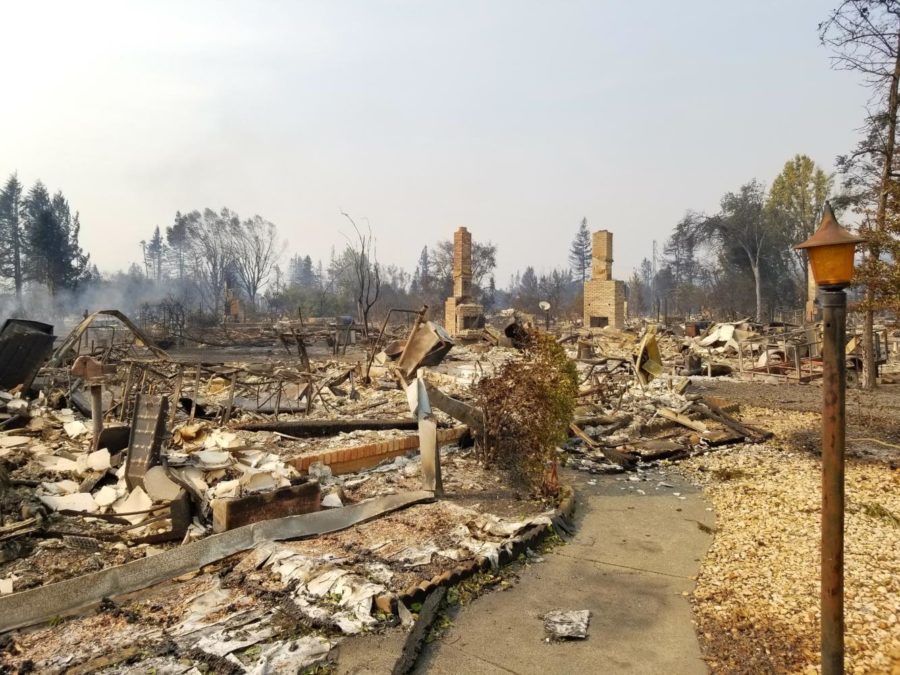Although October’s wildfires spared his Santa Rosa home near the Coffey Park neighborhood, Santa Rosa Junior College fashion design major Garrett Cledd and his family are still losing their home.
Cledd lives with his father and his father’s girlfriend on Tedeschi Drive, where they rent a four-bedroom house on a month-to-month lease agreement. Many property owners in Santa Rosa are taking advantage of the high home prices due to the increase in demand and decrease in supply following the fires.
“They want to raise the price of the house and sell it,” Cledd said. “You’re just kind of f***ed because fire victims are getting first priority, as they should. Those people lost everything.”
What used to be affordable is now too expensive for people who lost everything.
“My dad’s not even looking because everything is out of our price range,” Cledd said. “The cheap stuff is already taken and there’s just not any options because everything is so expensive these days.”
Cledd’s is one of many stories in post-fire Santa Rosa. Higher-income residents who lost their homes in the fire are able to out-compete lower-income renters, who are forced out. The costs of the housing loss are being diffused to the region’s most vulnerable residents.
A 2016 survey by the Office of Institutional Research on housing found 1.4 percent of SRJC students were in some condition of homelessness and 10 percent experienced housing problems as a major barrier to academic success.
According to a research project by the Sonoma County League of Women Voters (LWV), Santa Rosa and Sonoma County lack sufficient affordable housing for residents in the low-to-moderate income brackets, a problem only exacerbated by the fires.
“A household with two persons employed full time at minimum wage would have to pay over half (54 percent) of their gross monthly income for a one-bedroom apartment,” the report said.
Housing is considered affordable when its cost does not exceed 30 percent of monthly income.
A majority of renters whose income falls below the median spend more than 50 percent of their income on rent, according to a Sonoma County report on housing and homelessness.
Furthermore, the LWV report states that nearly half of Sonoma County’s young people want to leave thearea due to its lack of affordability.
According to The Santa Rosa 2016 Housing Action Plan, the city severely lacks affordable housing.
“This is indicated by rising residential rents and prices, dislocation of working families to other communities (increasing commuting), and increasing reliance on sub-standard housing, over crowding and other coping mechanisms.”
All of these factors threaten the college’s enrollment, already crippled in recent years as students are pushed into the workforce and away from higher education due to the increased cost of living in the area.
THE CRISIS NOW
Before the fires, the California Housing Partnership Corporation (CHPC) estimated Sonoma County needed more than 17,000 affordable rental homes to meet the needs of low-income renters. The fires cost the county an additional 4,000 units.
Pre-fire Santa Rosa alone had a deficit of 3,950 housing units and the additional loss of housing in the wildfires brought the total units needed in the county seat to nearly 7,000.
The county suffers a dangerously low vacancy rate of 1.5 percent. A Sonoma County Economic Development Board report, “Building HOMES: A Policy Maker’s Toolbox for Ending Homelessness,” said the optimum vacancy rate in a healthy housing climate is between 6 and 7 percent.
The worry is not necessarily that Sonoma County will become a place reserved for high-income earners, but that the lack of workforce housing is unhealthy for the economy. Shortages in the provision of basic services could occur if the employees fill those positions have to leave the area to find affordable housing.
“If we do not find real solutions to our housing crisis soon, we will see more and more of our younger population and families leaving the area,” the LWV report said. “This will cause the median age to grow higher and higher, until we become primarily a senior community.”
Seniors between the ages 65-84 are the fastest growing population in Sonoma County, increasing by 22,000 between 2006 and 2015.
Without enough affordable housing for lower-to-moderate income residents who make up the workforce, Sonoma County risks losing the workers essential to its booming economy.
HOW WE GOT HERE
Debbie Mckay, a LVW member who worked on the organization’s research project, said the region is feeling the long-term effects of the 2008 economic recession, which crippled the housing industry nationwide.
“We’re partly the victim of the bust in the housing industry because not a lot of housing has been built from 2008 to now,” McKay said.
State and local policies make California a particularly expensive place to build homes. Strict housing regulations, like those enacted by the California Endangered Species Act (CESA), raise the cost of housing.
“We have pretty strict building codes in California,” McKay said. “There’s a lot of things that drive up the cost of housing, like having urban growth boundaries. Some of these are good policy, but they have the unintended consequence of making land less available.”
Amid the state budget crisis in 2011, Gov. Jerry Brown ended a state redevelopment program, which provided municipalities with funding needed to build
affordable housing.
In response to the lack of state funding for affordable housing, municipalities like those in Sonoma County increased fees, a move that sometimes had the unintentional effect of increasing costs to developers and decreasing the incentive to build low-income units.
Urban growth boundaries are intended to keep communities separated by unoccupied land, preserving the insularity of cities but reducing the total available land for building.
Santa Rosa has historically had strict local policies as well, including zoning restrictions on the height of buildings and density of units in a given area. McKay said these restrictions were designed in a time when Santa Rosans wanted to prevent the city from becoming too big with structures corrupting its picturesque views.
HOMELESSNESS
Nowhere is the housing crisis more visible and acute than in the homeless population. Santa Rosa instituted a Housing First policy in dealing with homelessness, which removes conditions on housing the homeless and makes treatment of the underlying causes of homelessness secondary to providing individuals with homes.
The National Alliance to End Homelessness said evidence- based Housing First is the most effective public policy strategy in dealing with the homeless. The LVW report argued that, in addition to being a public health crisis, homelessness is more costly to the public than it would be to provide affected individuals with housing.
“Data from communities across the country show that public costs incurred by those experiencing extended periods of homelessness include emergency room visits, interactions with law enforcement, incarceration, and regular access to social supports and homeless services,” the report said. “These combined costs are often significantly higher than the cost of providing individuals with permanent housing and supportive services.”
Although the county’s homeless population has decreased since the recession due to improved economic conditions, falling from 4,539 in 2011 to 2,835 in 2017, the lack of affordable housing makes the Housing First solution for the remaining homeless residents untenable.
DEVELOPING SOLUTIONS
The Sonoma County Community Development Commission (SCCDC) works to promote the production of affordable housing in the region.
Felicity Gasser, senior community development specialist of the commission, said the housing crisis may get worse before it gets better, especially with changes to the tax code on the federal level.
Gasser said some vulnerable renters will likely continue to face eviction as the housing market adjusts to the loss of supply from the fires.
“There will be a secondary wave of displacement where the rental market is going to get even tighter,” Gasser said. “Prices will go up and people who were living here may be displaced because of the fires.”
Public investment in development, increased creativity in working with potential financiers and increased access to funding mechanisms like tax credits are necessary to recover.
Gasser said the effort to solve the problem will require collaboration between local jurisdictions and the county.
“From our agency’s perspective, the response to the housing crisis is going to have to be a collaborative effort between our community partners and city and county agencies,” she said.
Santa Rosa and the county have worked to reduce regulations during the fire, including incentivizing the construction and conversion of granny units and temporarily prohibiting existing housing stock from being used for vacation rentals.
According to McKay, the region, which has long resisted building tall housing developments with high occupant density, will have to revisit restrictive regulations to combat the shortage and its accompanying problems.
“We would look at densities and height restrictions, and try to be innovative,” McKay said. “We would also look at how to do greener housing, which could reduce the cost of housing by lowering utilities.”
“What we can expect to see is a very slow process. I think ideally, we would build smarter from this.”





